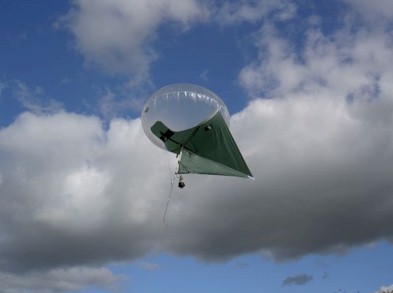|
Mainland High School
Suitable for a Disaster: ISTF 08-1835 |
||
|
Home
Introduction Contest Components One Two  Product Product
Three Fabrics History of Fabrics Smart Fabric Projects Sensors Nano Sensors Power Production Communication Cell Phones 3G Phones Data Transfer Helikites Interoperability Microwaves Relief Agencies Telecommunication Project Assessment Team |
Helikites
Allsopp Helikites Ltd. was founded in 1993 by Sandy Allsopp. Later, on January 25th, 2000, she was issued US Patent #6016998 - Kite Stability and Weight for her research. Helikites,TM a combination of balloons and kites, have overcome many of the challenges of their predessors. For example, balloons are pushed down by wind, but helikites are pushed up by wind. Plus, helikites can fly in still air, unlike kites. Helikites also have the ability to fly thousands of miles up in the air even in strong winds. Because the helikite includes a fat, round balloon, there is relatively little impact to drastic temperature changes, whereas a normal balloon would shrink as soon as it hits cold air due to the gas inside shrinking and a loss in the pressure needed to retain its shape. Another great advantage of helikites is their ability to be stacked one above the other which increases the lift on the same line. This can save helium, time, and personnel. The helikite can be lifted to any height as long as there is atmosphere to support it. Wind or no wind, the helikite will do the job itself. Helikites are the most common type of aerostat sold in the United Kingdom. Allsopp has 5,000 square feet of hanger space available for product testing. They also have two test-flight areas: one is a square kilometer of varied terrains such as buildings, fields, marshlands, woodlands, hills, and ponds, and the other is a 20-acre field located right next to the privately owned hanger. Helikites can be readily purchased in a multitude of countries. The price varies depending on the thickness of the balloon, the amount of helium required to inflate it, the required lift, and the maximum wind speed in which it can be operated. In an email dated 25 February, 2009, Sandy Allsopp informed us that our project would
... minimally require a 6-inch thick, 64-m3 skyhook which
would be able to operate in a 70-mph wind and lift a 25-kilogram (55 pound) payload.
Helium canisters to fill the Helikite would need to be under 200 bar (2900 psi)
of pressure and take about 15 minutes to fill the helikite. It would fly
between 7-10 days without needing any maintenance. The model we needed would cost
approximately £23,000 ($30,000 USD).
Allsopp Helikites Limited - About Us http://www.allsopphelikites.com/index.php?mod=page&id_pag=2 Patent Storm - Kite stability and weight http://www.patentstorm.us/patents/6016998/fulltext.html Allsopp Helikites Limited - Why Do Helikites Fly So Well? http://www.allsopphelikites.com/index.php?mod=page&id_pag=37 Allsopp Helikites Limited - Prices http://www.helikites.com/price/index.html Allsopp Helikites Limited http://www.allsopphelikites.com/ |


